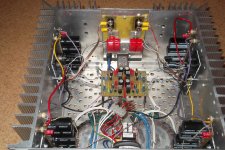Thanks Dude, Merry Christmas Christophe, Juan Antonio.
Merry Merry to the rest of diyers from this thread group and specially for the Shepard. I consider is not necessary another version of CSX1-2 with source follower.
Merry Merry to the rest of diyers from this thread group and specially for the Shepard. I consider is not necessary another version of CSX1-2 with source follower.
Last edited:
Bias supply question. I have my bias supply setup with transformers to bridge rectifiers (not visible). I've tested them and they work perfectly but I have one question. Do I have to reference the output of my bridge rectifiers to chassis ground in any way or just run the -/+ output directly to the connections on my Permaneder boards?
Regards,
Dan 🙂

Regards,
Dan 🙂

Bias supply question. I have my bias supply setup with transformers to bridge rectifiers (not visible). I've tested them and they work perfectly but I have one question. Do I have to reference the output of my bridge rectifiers to chassis ground in any way or just run the -/+ output directly to the connections on my Permaneder boards?
Regards,
Dan 🙂

They float 🙂
Connect them direct to the board.
Last edited:
My adventures with SIT PP
I had F5 with regulated PSU from Zen v5. Although it played reasonable good I came to the idea that complementary amp on SIT's would be even better. So decided to turn it into SIT Push-Pull. To make matter simpler I decided not to use Jensen and instead use capacitors at the input like in Zen5:
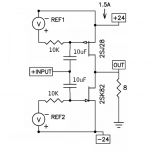
1) What I needed was just a bias circuit from Nelson article.
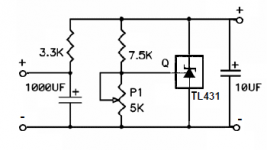
Project looked simple and straitforward. Got down to work.
But I had problem in one chanel. Bias voltage on 2SK82 droped after switching power on from -11.8V to something like +0.5, at the same time voltage on R11 rise showing high current going through transistors. Check if there was kind of shortcircuit to chassis, didn't find any. After changing several element including TL431, I fixed that chanel but then had similar problem in second one. So either left or rigth chanel was running, but not both at the same time. Managed to play some music on one or second chanel. Still then same problem of loosing bias voltage after switching main power supply. Additionaly during the process of experimenting and rebuilding bias circuit I lost some of TL431.
2) Suspecting any kind of gate leakage on SITs I decided that I need voltage regulator with more current capability and it could be just regular circuit from TL431 datasheet.
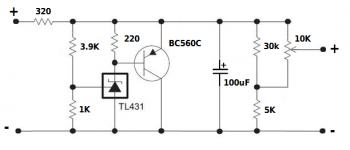
This time I managed to fire up both chanels without bias voltage problems although voltage at the output seemed to wander a bit. Happiness didn't last long. After connecting speakers I found there was substantial hum. That hum was in form of perfect rectangular signal amplitude of 0.167 V peak to peak/frequency100Hz.
3) I decided that high current TL431 regulator was bad idea since it induced to much hum for unknown reasons and it would be much better to use bias circuit from my version of L'SIT amplifier.
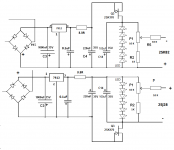
At least it was something checked with a great success in L'SIT amplifier. So I did.
To my surprise I found that there is still a bit of hum around - 50mV/100Hz. This time shape was different, more triangular:
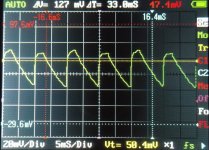
Frankly speaking I don't get it. Canibalized F5 was dead quiet but SIT PP is huming. L'SIT using the same bias circuit is dead quiet too.
Either one or second chanel was playing good without any hum with simple TL431 shunt regulator, but there were constant problems with them.
Can anybody explain it ???
I had F5 with regulated PSU from Zen v5. Although it played reasonable good I came to the idea that complementary amp on SIT's would be even better. So decided to turn it into SIT Push-Pull. To make matter simpler I decided not to use Jensen and instead use capacitors at the input like in Zen5:

1) What I needed was just a bias circuit from Nelson article.

Project looked simple and straitforward. Got down to work.
But I had problem in one chanel. Bias voltage on 2SK82 droped after switching power on from -11.8V to something like +0.5, at the same time voltage on R11 rise showing high current going through transistors. Check if there was kind of shortcircuit to chassis, didn't find any. After changing several element including TL431, I fixed that chanel but then had similar problem in second one. So either left or rigth chanel was running, but not both at the same time. Managed to play some music on one or second chanel. Still then same problem of loosing bias voltage after switching main power supply. Additionaly during the process of experimenting and rebuilding bias circuit I lost some of TL431.
2) Suspecting any kind of gate leakage on SITs I decided that I need voltage regulator with more current capability and it could be just regular circuit from TL431 datasheet.

This time I managed to fire up both chanels without bias voltage problems although voltage at the output seemed to wander a bit. Happiness didn't last long. After connecting speakers I found there was substantial hum. That hum was in form of perfect rectangular signal amplitude of 0.167 V peak to peak/frequency100Hz.
3) I decided that high current TL431 regulator was bad idea since it induced to much hum for unknown reasons and it would be much better to use bias circuit from my version of L'SIT amplifier.

At least it was something checked with a great success in L'SIT amplifier. So I did.
To my surprise I found that there is still a bit of hum around - 50mV/100Hz. This time shape was different, more triangular:

Frankly speaking I don't get it. Canibalized F5 was dead quiet but SIT PP is huming. L'SIT using the same bias circuit is dead quiet too.
Either one or second chanel was playing good without any hum with simple TL431 shunt regulator, but there were constant problems with them.
Can anybody explain it ???
Last edited:
Yes they are. Both chanels share the same power transformer for bias but negative and positive bias are fed from separated windings.
Do you just mean to check where the hum is coming from ? Main rails or bias PSU ?recheck with CRO between +/- of main PSU rails , same for opposite bias rails
Don't you ?
there must be superposition between opposite rails ripple and you need to confirm that
if you confirm it , hum must be either from ground loop or field induced in signal xformer
if you confirm it , hum must be either from ground loop or field induced in signal xformer
I found my error !
I wanted to increase voltage coming out of bias circuit for 2SJ28 to avoid curent inrush and added voltage divider at the leg No2 of LM7812 regulator - resistors 560R and 68R on the picture below:
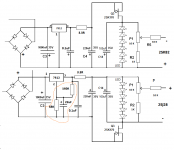
My fault was that I put too small capacitor across res. 68R i.e. 0.47uF, but it should be something like 22-47uF. Didn't know it can be so significant. Now noise dropped around ten fold. Leter I change caps 0.1uF in the LM7912 bias for 2SK82, into 22uF which helped a bit too.
I wanted to increase voltage coming out of bias circuit for 2SJ28 to avoid curent inrush and added voltage divider at the leg No2 of LM7812 regulator - resistors 560R and 68R on the picture below:

My fault was that I put too small capacitor across res. 68R i.e. 0.47uF, but it should be something like 22-47uF. Didn't know it can be so significant. Now noise dropped around ten fold. Leter I change caps 0.1uF in the LM7912 bias for 2SK82, into 22uF which helped a bit too.
Hi,
I've never worked with TO-3 parts. I wonder if I should use sockets like these
to mount the transistors:
10SETS Bakelite Gold Plated PIN TO 3 Transistor Socket Silicon Rubber Screw | eBay
Thanks,
Dennis
I've never worked with TO-3 parts. I wonder if I should use sockets like these
to mount the transistors:
10SETS Bakelite Gold Plated PIN TO 3 Transistor Socket Silicon Rubber Screw | eBay
Thanks,
Dennis
Hi,
I've never worked with TO-3 parts. I wonder if I should use sockets like these
to mount the transistors:
10SETS Bakelite Gold Plated PIN TO 3 Transistor Socket Silicon Rubber Screw | eBay
Thanks,
Dennis
I have successfully used these, 4601 Keystone Electronics | 4601K-ND | DigiKey
Regards,
Dan 🙂
Thanks Dan.
Dennis
- Status
- Not open for further replies.
- Home
- Amplifiers
- Pass Labs
- Article - Sony VFETs part 1



